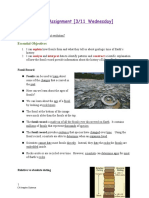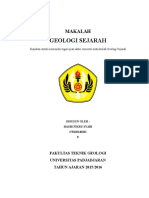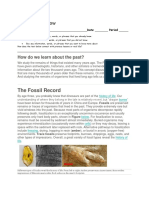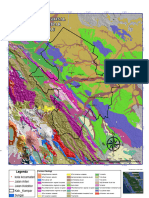Fossils - Rocks - and - Time (Tibay, John)
Uploaded by
Chrystelle Mariano TibayCopyright:
Available Formats
Fossils - Rocks - and - Time (Tibay, John)
Uploaded by
Chrystelle Mariano TibayOriginal Title
Copyright
Available Formats
Share this document
Did you find this document useful?
Is this content inappropriate?
Copyright:
Available Formats
Fossils - Rocks - and - Time (Tibay, John)
Uploaded by
Chrystelle Mariano TibayCopyright:
Available Formats
Name: John Meydrick M.
Tibay Date: January 8, 2022
Section: STEM 18
1. Explain the difference between "relative time" and "numerical time."
The subdivision of rocks found in Earth's geology, as well as the time and order of events
they reflect, is known as relative time, while numerical time is determined by taking
measurements of time in millions and billions of years from the same rocks to determine how
much time has passed.
2. Explain the overarching structure of the geologic time scale (i.e., the placement of eons,
eras, periods, and epochs).
Geologic time scale is a chronological time scale that is used to classify geological strata
or stratigraphy over time. Geological time scales are divided into eons, which are further
subdivided into eras, which are further subdivided into periods, which are then further
separated into epochs.
3. What is a paleontologist?
Paleontologists are scientists that specialize in studying ancient life forms such as fossils.
Bones, shells, or leaves, as well as other signs of past life on Earth, such as tracks, burrows, or
impressions, are examples of fossils.
4. Why do the authors say that the layers of rocks are the pages in earth's history book?
The authors say that the layers of the rocks are the pages in earth’s history book
because the changes in rocks’ layer have proper order that can be use in investigating earth’s
history.
5. What are sedimentary rocks?
Sedimentary rocks are made up of particles of older rocks that have been shattered by
water or wind. Sandstone, limestone, and shale are some examples of sedimentary rock.
6. What is the Law of Superposition and why is it critical to our interpretation of earth's
history?
The law of superposition is a basic principle of stratigraphy that states that the oldest
layer is at the bottom of a sequence of sedimentary rock layers and that the layers get younger
with ascending order in the sequence. This Law of Superposition is critical to interpretation of
earth’s history because it shows the relative ages of rock layers and the fossils inside them at
any given location.
7. What is the Law of Original Horizontality and what does it help us understand about
sedimentary rocks that are no longer horizontal?
The Law of Original Horizontality states that all rock layers are put out horizontally at
first and can be distorted afterwards. This includes mountain building events, earthquakes, and
faulting. The Law of Horizontality helps us understand about sedimentary rocks that are no
longer horizontal by telling us that sedimentary rocks that is non-horizontal were either created
in unusual ways or, more commonly, were shifted from their horizontal position by later events.
You might also like
- ls3 Explore Principles of Relative Dating ArticleNo ratings yetls3 Explore Principles of Relative Dating Article5 pages
- ES Study Guide - Lesson14-History-of-Earth-through-Geologic-Time-ScaleNo ratings yetES Study Guide - Lesson14-History-of-Earth-through-Geologic-Time-Scale16 pages
- Geology for Engineers Learning Module 2 3No ratings yetGeology for Engineers Learning Module 2 350 pages
- Relative Dating Is The Science of Determining The Relative Order of Past EventsNo ratings yetRelative Dating Is The Science of Determining The Relative Order of Past Events8 pages
- Layers of Rocks (Stratified Rocks) : ObjectiveNo ratings yetLayers of Rocks (Stratified Rocks) : Objective14 pages
- Handout No. 6 in Earth Science: Co Qah + Melc LWNo ratings yetHandout No. 6 in Earth Science: Co Qah + Melc LW5 pages
- LESSON 13 GEOLOGIC TIME SCALE_with answer keyNo ratings yetLESSON 13 GEOLOGIC TIME SCALE_with answer key49 pages
- DEFINING-AND-IDENTIFYING-SUBDIVISIONS-FOSSIL-INDEX-copyNo ratings yetDEFINING-AND-IDENTIFYING-SUBDIVISIONS-FOSSIL-INDEX-copy30 pages
- ESQ2 LESSON 15 Subdivisions of Geologic TimeNo ratings yetESQ2 LESSON 15 Subdivisions of Geologic Time11 pages
- Daily Assignment (3/11 Wednesday) : Essential QuestionNo ratings yetDaily Assignment (3/11 Wednesday) : Essential Question2 pages
- P2 Rv Oct14 2024 ES4 Geological Time Scale Only Till Slide 25No ratings yetP2 Rv Oct14 2024 ES4 Geological Time Scale Only Till Slide 2552 pages
- Lecture No. 15 DEFINING AND IDENTIFYING SUBDIVISIONS OF GEOLOGIC TIME SCALE USING INDEX FOSSILSNo ratings yetLecture No. 15 DEFINING AND IDENTIFYING SUBDIVISIONS OF GEOLOGIC TIME SCALE USING INDEX FOSSILS2 pages
- Module 3 Part 1 Earth Science - History of The EarthNo ratings yetModule 3 Part 1 Earth Science - History of The Earth5 pages
- Geologic Time Scale Glossary:: Uc-Shs 1No ratings yetGeologic Time Scale Glossary:: Uc-Shs 143 pages
- 7 A Introduction to Linear Regression - AnswersNo ratings yet7 A Introduction to Linear Regression - Answers4 pages
- SHD8802 - MechWarrior Perssonnel File - KuritaNo ratings yetSHD8802 - MechWarrior Perssonnel File - Kurita13 pages
- Risk and Management Accounting Best Practice GuideNo ratings yetRisk and Management Accounting Best Practice Guide9 pages
- P9. CMA INTER OM&SM (MCQs)_75729bfb-7668-4a13-837b-80a35cb87eb8No ratings yetP9. CMA INTER OM&SM (MCQs)_75729bfb-7668-4a13-837b-80a35cb87eb830 pages
- Get Clinical Director of Pathology Tackling the Role 1st Edition Mike Galloway PDF ebook with Full Chapters NowNo ratings yetGet Clinical Director of Pathology Tackling the Role 1st Edition Mike Galloway PDF ebook with Full Chapters Now77 pages
- B Tech First Year Timetable (JUL-NOV-2023) W.E.F 28 Aug 2023No ratings yetB Tech First Year Timetable (JUL-NOV-2023) W.E.F 28 Aug 202336 pages
- Applied Mathematics-I (MATH114) : Lecture1: Introduction and Basic of MatricesNo ratings yetApplied Mathematics-I (MATH114) : Lecture1: Introduction and Basic of Matrices15 pages

























































































